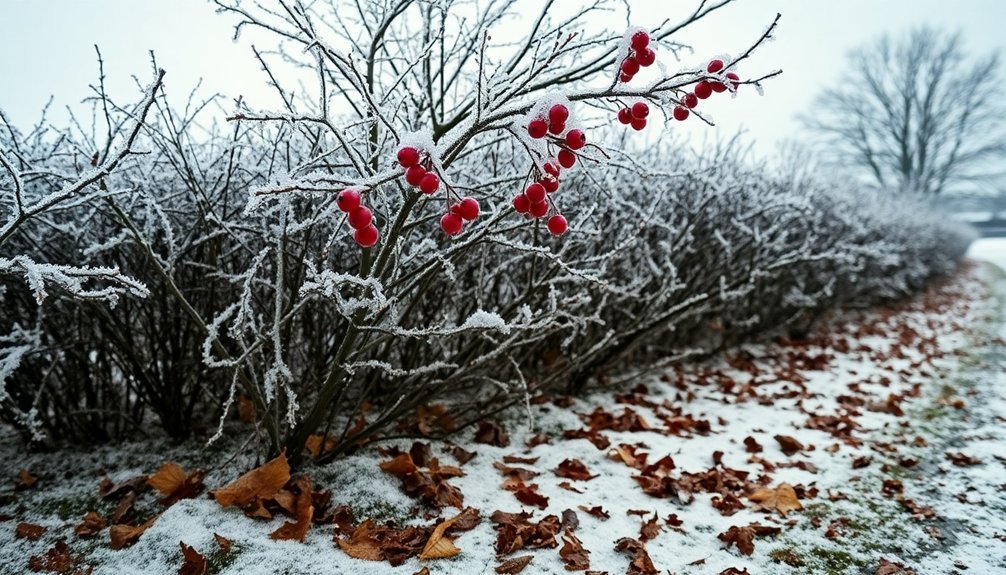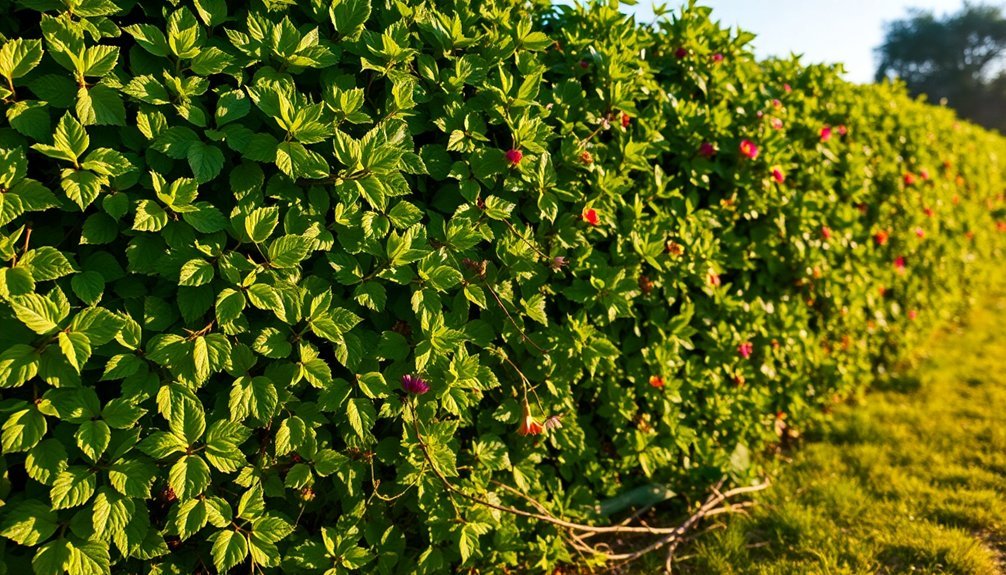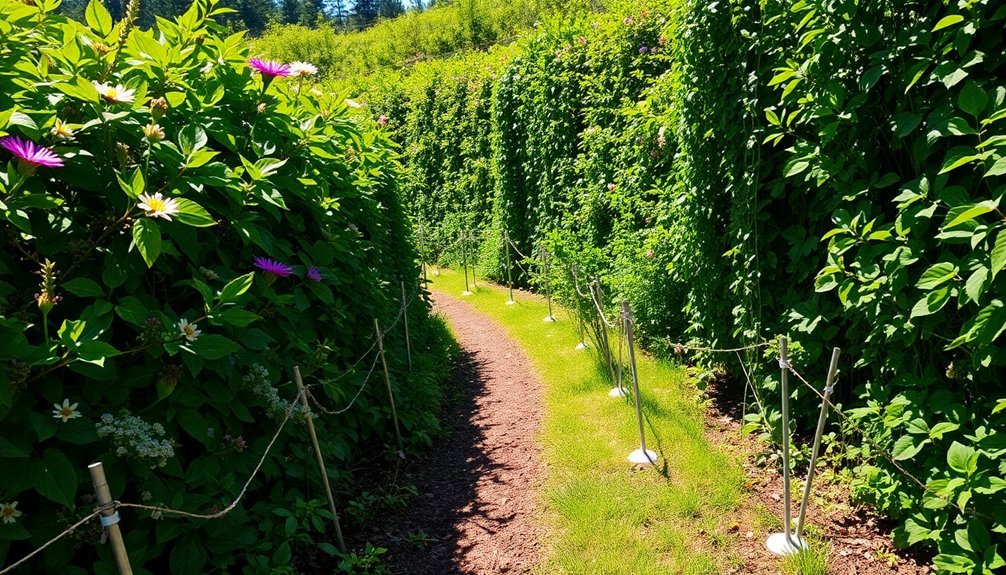Effective hedgerow management follows five annual steps: winter assessment using tools like the Healthy Hedgerows app, spring biodiversity enhancement through strategic cutting and gap-filling, summer growth monitoring with selective maintenance, autumn harvesting while preserving wildlife food sources, and implementing year-round protection measures against extreme conditions. You'll maintain an A-shaped structure for ideal sunlight penetration and create thriving wildlife corridors. The full lifecycle approach reveals how these living boundaries transform with proper seasonal care.
Winter Assessment and Planning Your Hedgerow Strategy

While many gardeners focus on spring and summer tasks, winter offers the perfect opportunity to assess and plan your hedgerow management strategy. With leaves down, you'll have clearer visibility of the woody structure and any issues requiring attention.
Begin by identifying your hedge boundaries, noting where each section starts and ends. Use tools like the Healthy Hedgerows app to conduct rapid surveys, documenting height, gaps larger than 20m, and overall condition. This rapid assessment method only requires answering six questions to place your hedges in their management lifecycle and provide appropriate options.
A thorough winter survey reveals your hedgerow's true state, informing smart management decisions for the seasons ahead.
Evaluate the structure using guidelines like the Adams Hedgerow Management Scale. Create a staggered management plan that prioritizes sections needing immediate attention while ensuring diverse lifecycle stages across your landscape.
Don't forget to review local regulations and explore funding opportunities for restoration projects. Your winter assessment forms the foundation for effective year-round management.
Spring Biodiversity Enhancement and Species Management
As spring awakens the dormant landscape, your hedgerow management should shift toward enhancing biodiversity and supporting the numerous species that depend on these essential habitats.
Time hedge cutting carefully to avoid disturbing wildlife, ideally cutting every 2-3 years. Rejuvenate older hedges through laying or coppicing, which creates valuable deadwood habitats. Fill gaps with native shrubs to strengthen wildlife corridors, particularly for small mammals.
Plant diverse flowering species to support pollinators throughout the season. Reduce chemical use near hedgerows to protect invertebrate populations. Create structured hedgerows with varying heights and maintain diverse vegetation at the hedge base. Implementing biennial trimming provides better nesting habitat for birds like grey partridge compared to other management approaches.
Pay special attention to priority species by preserving their specific habitat requirements. Remember that adjacent land use considerably impacts your hedgerow's biodiversity value.
Summer Growth Monitoring and Selective Maintenance

Summer transforms your hedgerow into a bustling ecosystem requiring vigilant monitoring and targeted maintenance. Track peak nectar production from herbaceous favorites like salvia, yarrow, and buckwheat while maintaining appropriate soil moisture during dry periods.
Implement mechanical weed control and targeted spot-spraying that won't harm pollinators. Assess tree and shrub health, pruning to maintain your hedgerow's A-shaped structure for maximum sunlight penetration. Consider cutting on a three-year rotation cycle to guarantee continuous flowering.
Leave some areas uncut to provide wildlife shelter and maintain unfertilized buffer zones for wildflower growth. Carefully observe pollinator activity, especially bees and butterflies, to gauge your hedgerow's effectiveness.
During extreme heat, implement drought management strategies while ensuring nectar availability for queen bumblebees preparing for hibernation. Remember that your hedgerow can provide cooler temperatures up to 15 degrees lower than surrounding fields, offering crucial relief for pollinators during summer heat waves.
Autumn Harvesting and Wildlife Habitat Preparation
Autumn transforms your hedgerow into a seasonal harvest treasury while creating vital wildlife preparations for the colder months ahead.
Gather elderberries when black, rowans when red and firm, and rosehips after the first frost (or freeze them to mimic this effect). Harvest hawthorn berries when deep red and slightly soft, and collect sloes for making gin.
Nature's autumn pantry awaits—harvest each wild fruit at its perfect moment of ripeness.
Remember to leave plenty of berries for wildlife that depend on these food sources. Your hedgerow provides essential shelter and nesting sites for birds, small mammals, and insects. When harvesting rosehips, always wear protective gloves to avoid injuries from thorny stems.
Maintain a balance of mature and young growth by pruning selectively in late winter. Dense, diverse hedgerows with native species support more local wildlife and serve as important corridors connecting fragmented habitats across the landscape.
Year-Round Protection Measures for Hedgerow Resilience

Maintaining hedgerow resilience requires consistent attention across all seasons, not just during growth periods.
You'll need to establish a dynamic management cycle that balances environmental needs with practical objectives.
Protect roots during winter by mulching and gently firming soil to eliminate air pockets.
Water lightly to prevent drying, but avoid waterlogging.
Use temporary covers during extreme conditions, removing them daily to prevent suffocation.
In spring, apply fertilizers to support new growth and cut evergreen hedges to reduce winter damage risk.
Summer calls for regular pest inspections and weed suppression through mulching.
Throughout the year, monitor hedge health through surveys, fill gaps promptly, and maintain a 6-8 feet clearing for fire protection.
Every few decades, rejuvenate aging hedgerows through laying or coppicing to guarantee long-term vigor.
When planting new hedges, choose the dormant period from autumn to spring for best establishment results.
Frequently Asked Questions
How Can I Determine the Optimal Height for My Specific Hedgerow Type?
Consider your hedgerow's species, garden depth, and orientation to windows. You'll want to maintain height below three-quarters of the plant's mature size while ensuring adequate light exposure for your property.
What Specialized Equipment Is Most Cost-Effective for Small-Scale Hedgerow Management?
For small-scale hedgerow management, an excavator-mounted finger bar at £2400 offers the best value. You'll get clean cuts in a single pass, minimizing ground damage while supporting healthy regrowth and biodiversity.
How Do I Address Invasive Species Without Harming Native Hedgerow Plants?
Use targeted mechanical removal for invasive species, focusing on their specific vulnerabilities. You'll want to apply spot treatments with herbicides, establish buffer zones around natives, and time your control efforts during invasive plants' vulnerable growth stages.
Can Hedgerows Be Effectively Incorporated Into Urban or Suburban Landscapes?
Yes, you can definitely incorporate hedgerows into urban and suburban landscapes. They'll provide wildlife habitats, improve air quality, create privacy, and add aesthetic value while connecting fragmented green spaces in developed areas.
What Funding or Grant Opportunities Exist for Hedgerow Restoration Projects?
You'll find diverse funding sources for hedgerow restoration including government programs like Countryside Stewardship Grants, private initiatives such as the Branching Out Fund, and community grants from local businesses and environmental foundations.
In Summary
By following these five seasonal steps, you'll transform your hedgerow into a thriving ecosystem that benefits wildlife while enhancing your property's beauty. You don't need to be a professional gardener—just consistent attention throughout the year will yield remarkable results. Remember, your hedgerow isn't just a boundary; it's a living habitat that you're nurturing for generations to come.





Leave a Reply